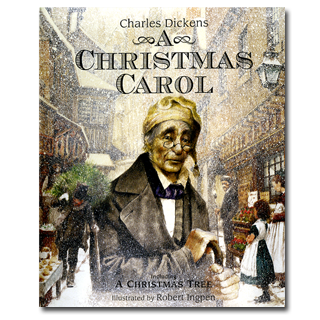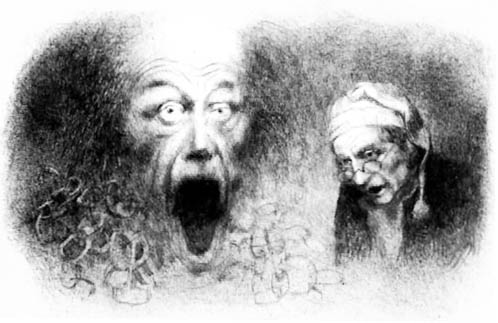
A FEW OTHER EVENTS FOR
DECEMBER 19:
- Happy birthday Eve Bunting (One More Flight, Smoky Night, and One Green Apple).
- It’s the birth date of Carter Woodson (1875–1950), considered the “Father of Black History,” who pioneered Negro History Week in February, which was eventually extended to Black History Month. Read African Myths and Folk Tales by Carter Woodson and Carter G. Woodson by Patricia and Fredrick McKissack.
- If you haven’t already, find the conifer of your dreams on Look for an Evergreen Day. Read Mr. Willowby’s Christmas Tree by Robert Barry and The Year of the Perfect Christmas Tree by Gloria Houston, illustrated by Barbara Cooney.
When Charles Dickens set out to write A Christmas Carol in 1843, both his fortune and his reputation had hit an all-time low. “Boz [Dickens’s pen name] is going down,” the gossips declared, and Dickens financial problems were known all over London. During this time the celebration of Christmas traditions in England were, as the poet Thomas Hood stated, “in danger of decay.” But Dickens short novella, written at fever pitch over a six-week period, would revive Dickens’s reputation as the most popular novelist in England. Also with this small novel he revitalized the Christmas holiday—just with the power of his pen.
Dickens drew on his own childhood and the life around him to fashion his story. Even the death of the child Tiny Tim was all too familiar to Dickens—he had lost a brother and a sister when a mere child himself. The boy Scrooge, left alone in the school during the holidays, finds children’s books to be his only friend, just as Charles Dickens did. And Dickens had been campaigning in 1843 on behalf of the children of the poor, an appeal that had found him an audience of believers. So drawing on experience and invention, Dickens locked himself in his house, excused himself from appointments, refused to see friends who dropped by, and worked all hours of the day and late into night. “No city clerk was ever more methodical or orderly than he,” Dickens’s eldest son Charley stated about his father.
As is often the case with groundbreaking books, Dickens met some opposition to his creation. Although Dickens told a touching tale of the miser Ebenezer Scrooge who was taught the meaning of Christmas by a series of ghostly visitors, his publisher didn’t think the offering had much value. Ever the inventor, Dickens suggested the terms of his own arrangement. He would pay for the production of the book and be entitled to all profits; his publisher would get a small commission on each sale. (This is, by the way, a complete reversion of usual publishing arrangements.) Since Dickens controlled the book’s production, he made some important decisions about this “Ghost Story of Christmas.” The price would be kept low, only five shillings; he made the small book as handsome as possible, with a russet cloth binding and a stamp of gold on the front and spine. Published on December 19, 1843, A Christmas Carol became an immediate sensation, going through several printings right away. Even the Scottish philosopher Thomas Carlyle, known to be dour, “on reading the book, sent out for a turkey, and asked two friends to dine.” Thousands of editions have been issued over the years. Australian illustrator Robert Ingpen, winner of the Hans Christian Anderson Award, created an expressive and spirited rendition of the book in 2008. Today, of course, A Christmas Carol can be enjoyed in plays and movies, even now in a graphic novel.
Happy birthday to A Christmas Carol. This book reminds us that, as Scrooge’s nephew Fred says, Christmas can be “a good time: a kind, forgiving, charitable, pleasant time: the only time I know of in the long calendar year, when men and women seem by one consent to open their shut-up hearts.”
Here’s a page from A Christmas Carol:
Marley was dead: to begin with. There is no doubt whatever about that. The register of burial was signed by the clergyman, the clerk, the undertaker, and the chief mourner. Scrooge signed it. And Scrooge’s name was good upon ‘Change, for anything he chose to put his hand to. Old Marley was as dead as a door-nail.
Mind! I don’t mean to say that I know, of my own knowledge, what there is particularly dead about a door-nail. I might have been inclined, myself, to regard a coffin-nail as the deadest piece of ironmongery in the trade. But the wisdom of our ancestors is in the simile; and my unhallowed hands shall not disturb it, or the Country’s done for. You will therefore permit me to repeat, emphatically, that Marley was as dead as a door-nail.
Originally posted December 19, 2010. Updated for .














A Christmas Carol is my favorite Christmas story. It was interesting to read about Charles Dickens, sounds like this story came from the heart.
While I loved reading Great Expectations, I don’t think I’ve actually read Christmas Carol from start to finish. I have seen A Muppet Christmas Carol; don’t laugh – Michael Caine was perfect as Scrooge. Thanks for the reminder about the book – I will read it to the kiddos this year.
Amy: Actually, many of us encounter, often as children, adaptations of books before we find the real thing. I recently picked up Pinocchio and realized that I had never read a full translation of the Italian text (only adaptations). Hope you enjoy reading A Christmas Carol for the first time. Anita
Thank you, Anita, for the wonderful history on Dickens’s classic Christmas tale! I have quite a few editions of this story, but I think the one illustrated by Lisbeth Zwerger is the most stunning. She captures in her illustrations the charm of 19th century English village life, and her depictions of Tiny Tim and the Cratchitt family are so endearing. There are clear reflections in her art of the influence of Arthur Rackham and I find Zwerger’s scene with Scrooge and Death very effective. Thank you, Anita for the wonderful holiday reminder! Merry Christmas to you!
Anita,
Thanks for inspiring kids and adults in equal measure. It is not an easy task to have to inspire the adults (tough and jaded crowd!) first, who then try share their enthusiasm with kids (the smiling crowd).
The Children’s Book-A-Day Almanac is all about extraordinary literature. I simply love that.
I am one of those who plan to read (aloud) A Christmas Carol in its full beauty for the first time as an adult.
Your post about A Christmas Carol kept the flame burning in my heart since Christmas 2010 and in mid-2011 I found a classic unabridged and illustrated version to my liking.
Had I not read your post, I would certainly have dismissed this book as “not for me”. But as soon as I saw the Dickens classic, everything I read about it here – simply clicked. (As Jill mentioned, your review came from the heart – so it stayed with me).
Now I have a great book to read aloud for Christmas.
Thanks for the inspiration (even with a delayed effect).
Read Aloud Dad
PS my favorite choice of “A Christmas Carol” is the P.J. Lynch illustrated version http://www.readalouddad.com/2011/12/ultimate-read-aloud-collection-for.html
ReadAloudDad: Thanks for your note and reminding everyone about the P. J. Lynch edition. I hope everyone can pick up their favorite version during the holiday season.
I love reading books by Dickens! I think Great Expectations is my favorite, but A Christmas Carol is second. I remember the Disney version of this…where Donald Duck is Scrooge and I think this is my favorite movie version. Possibly because it is very kid friendly. Thanks Anita! And Merry Christmas!!
I’m addicted to Anita’s background stories on authors and their works. Oh how I love this magical thing she does.
I recall being really surprised when I started reading the actually Christmas Carol novel by Dickens. All those video versions of Christmas Carol we’ve seen sort of gives one the idea the film is all there is. Far from it. Dickens language is still far and away one of the most beautifully written efforts known. I don’t think may people realize just how emotionally profound his writing can be.
I envy anyone who has not read Bleak House, and is about to.
Another book I have to have during this time is The Gift of the Magi, by O’ Henry. Watch out for short version of this as well.
Oh. Okay. While I’m at it, a third thing I have to have this time of the year is Dylan Thomas’s A Child’s Christmas In Wales. His language flows and even though it often makes no sense, you love it anyway.And then there’s The Snowman, and, and.. Well, I better stop. Grin..
This is one of my favorite Christmas stories. I read it every year!
I’m so excited to find out that others (particularly other writers!) love Dickens’s wonderful story. I just posted about it myself! Great background, Anita. Thanks!
THAT’S IT! I’m reading this out loud to the kids. Starting tonight. Thanks for the inspiration!
Is it just me or are those illustrations somehow reminiscent of Steven Gammell’s Scary Stories? Interesting interpretation!